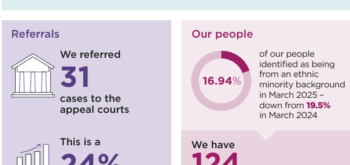[contextly_auto_sidebar]

Supreme court sketch (R v Jogee), www.isobelwilliams.blogspot.co.uk
Joint enterprise is an aspect of the criminal law of England and Wales that has long been complicated, confusing, and subject to multiple and often conflicting interpretations. Guidance on joint enterprise issued by the CPS in 2012 identified three broad types of joint enterprise, namely:
- Where two or more people join in committing a single crime, in circumstances where they are, in effect, all joint principals.
- Where D assists or encourages P to commit a single crime.
- Where P and D participate together in one crime (crime A) and in the course of it P commits a second crime (crime B) which D had foreseen he might commit.
Following the February 2016 Supreme Court judgement in R v Jogee and Ruddock v The Queen (Jamaica) [2016] UKSC 8; [2016] UKPC 7, the third of the above types of joint enterprise – commonly described as ‘parasitic accessorial liability’, and the source of much if not all of the recent controversy about joint enterprise – has effectively been abolished. The Supreme Court ruled that the law had taken a ‘wrong turn’ in introducing this form of secondary liability around three decades ago. The essential error was that defendants’ foresight of an offence was treated as equivalent to their intent to assist or encourage that offence, which had the effect of over-extending the scope of secondary liability.
It is to be hoped that this judgment will substantially reduce the potential for miscarriages of justice and perceived ‘dragnet’ prosecutions and sentencing under the joint enterprise doctrine. However, to whatever extent the Supreme Court judgment serves to ‘correct’ certain problems in the development and application of the law on joint enterprise, the damage that has been done to the legitimacy of the courts system and judiciary as a consequence of these problems is likely to be substantial. Recovery from the deficit in legitimacy will doubtless take time.
Meanwhile, constructive debate on the law on joint enterprise, and consistency and fairness in its application, may be hampered by continuing misperceptions and misunderstandings. Even if the Supreme Court judgment goes some way towards simplifying the law, questions of how and why principal and accessorial liability are ascribed in serious cases remain complex. As things stand, furthermore, there are no provisions for routine recording and monitoring of cases involving forms of joint enterprise, and hence systematic information on the application of the doctrine is almost entirely lacking.
There is an urgent need for the existing information gap to be addressed and for greater clarity and transparency in the prosecution of joint enterprise cases. The following recommendations, aimed at policy-makers and practitioners engaged in all aspects of the judicial process, are intended to enhance clarity and transparency in the prosecution of joint enterprise cases.
Recommendations on charging decisions and recording
- The CPS should ensure that, in all cases in which more than one defendant is charged with the same offence in relation to the same incident(s), the alleged basis of liability is identified and recorded on file. This should entail routine notification, as part of completion of the charging decision form, of the following information with respect to each defendant:
- Whether the defendant is charged as a principal, accessory or as either a principal or accessory
- If charged as a (possible) accessory, the basis of this – for example:
- Having participated in the offence to assist its commission
- Having assisted the commission of the offence without being present
- Having encouraged the commission of the offence
- Having counselled or procured the offence
- A combination of any of the above
- The recording of alleged principal and/or accessorial liability should be updated where charges are amended during the prosecution process and at the verdict.
- The Ministry of Justice or HM CPS Inspectorate should undertake a review to support the trialling and development of the new charging and recording system outlined above, and to monitor prosecutions following the introduction of the system. The findings of this review should, further, help to determine whether there is a need for legislative change, alongside the evolution of case law, to promote more consistent and proportionate approaches to prosecuting multi-defendant cases.
Recommendations on communications
- As part of current development of the Common Platform for digital management of case information across the criminal justice system, provision should be made for collation and publication of national figures on:
- Cases in which two or more defendants were convicted of the same offence in relation to the same incident, by offence category and CPS area
- Defendants so convicted, by offence category and CPS area.
- Better identification and recording of the basis of (principal and/or accessorial) liability as alleged against each defendant in multi-defendant cases should help to ensure that practitioners fulfil their existing obligations to keep defendants and complainants fully informed about charges and any forthcoming trial.
- Guidance should be provided to judges on appropriate ways to cover issues of principal and accessorial liability in their delivery of sentencing remarks, with a view to ensuring that defendants, victims and all others concerned in a case (including any reporters covering it) have a clear understanding of the basis on which each individual has been convicted.
- In recent years, the term ‘joint enterprise’ was subject to differing definitions and, because of the surrounding controversies, became increasingly toxic. With its observation that ‘joint enterprise’ is ‘not a legal term of art’, and by limiting joint liability to scenarios in which defendants either are joint principals or one aided, abetted, counselled or procured another, the Jogee and Ruddock ruling takes a large step away from the older terminology. Relevant bodies should seek to develop an alternative terminology which will aid rather than inhibit clear communication about multi-defendant cases.
Recommendations on sentencing
- The Sentencing Council should give consideration to the provision of guidance on the principles to be followed in the sentencing of multiple offenders whose specific roles with respect to the offence or offences are not known.
- Where a defendant is convicted for murder as an accessory and is substantially less culpable than the principal, the judge has limited capacity to reflect this at sentencing because of the mandatory life sentence for murder. As has been urged in the past by the Law Commission among many others, we recommend that the government should review the mandatory life sentence for murder.
This piece is drawn from Joint Enterprise: Righting a Wrong Turn? by Jessica Jacobson, Amy Kirby and Gillian Hunter from the Institute for Criminal Policy Research, Birkbeck, University of London. You can read the full report here.






